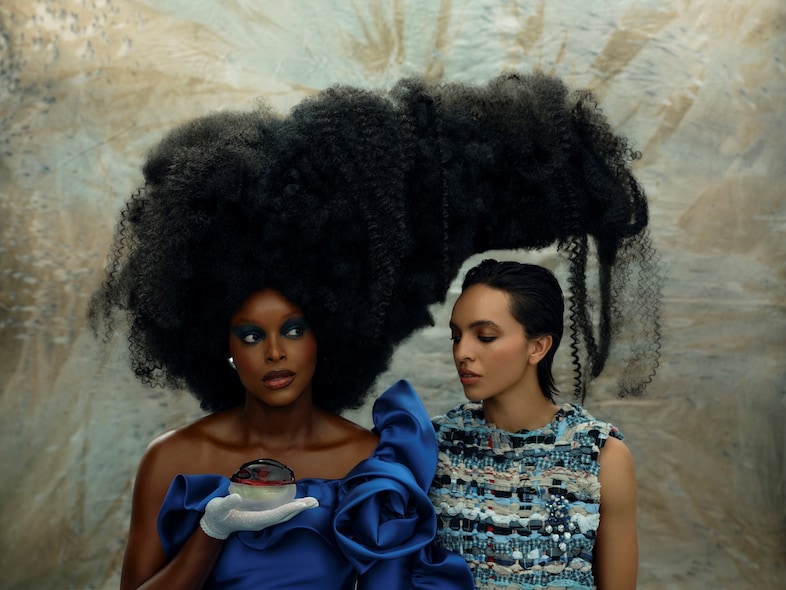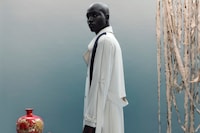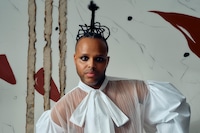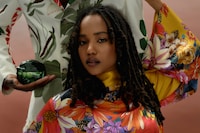Artist Manuel Mathieu channels memory, migration, and the spirit of Haiti into his first fragrance collection – a sculptural trio of scents created with master perfumer Juliette Karagueuzoglou
- Who is it? An inaugural line of perfumes from artist Manuel Mathieu
- Why do I want it? A suite of scents rooted in Mathieu’s personal history and created with an avant-garde approach. The bottles, works of art in and of themselves, function as standalone sculptures
- Where can I find it? Manuel Mathieu Parfums is available to pre-order directly via the brand’s website
Who is it? Manuel Mathieu, who hails from Haiti and studied Fine Arts at Goldsmiths in London, has always been interested in the realm of the invisible. Memories and figures from the past swirl inside his paintings, vivid abstract canvases that pulse with life and pay homage to his birthplace. Mathieu moves deftly between mediums, working across painting, sculpture, photography, and film. Now, scent is one of them.
Mathieu started his journey of fragrance creation while in Paris for an artist residency. He initially wanted to “become a nose,” he explains, referring to the term used to describe those who specialise in scent, highly specialised practitioners not unlike composers or chefs. The task proved to be more complicated than he thought. Mathieu met with multiple noses – from the likes of Cartier and Hermès – before landing on Juliette Karagueuzoglou. She and Mathieu worked together for eight months to develop three fragrances: Dsire, île noire, and Eccco.
Why do I want it? Manuel Mathieu Parfums offers “an artistic experience in a retail environment,” explains Mathieu. Moulded from hand-built sculptures made of clay, each bottle carries the imprint of Mathieu’s careful handiwork.

“Juliette told me if I wanted to do something valuable, I had to reveal myself,” says Mathieu. Mathieu decided to tell a “geological story in relation to the land.” Haitian vetiver, the best in the world, forms the base of all three fragrances. Rooted in Mathieu’s intimate memories and experiences of Haiti, each perfume represents a stage in a three-part cycle: Dsire the innocence of rebirth, Île noire “the point of maturity,” Eccco the aftermath of a fictional volcanic eruption that envelops and floods the entire island. The water “creates a ripple, which is why Eccco has three ‘c’s’,” Mathieu explains.
Dsire, bright and creamy with top notes of jasmine and grapefruit, evokes the sweet brininess of salt on skin. (Think of a summer afternoon, restless air moving through trees. You brush up against a patch of frangipani. Later you find a spring of crushed tuberose in your pocket. You take it out. Some sap bleeds onto your fingers.) “I wanted to create something soothing, warm, [and] motherly,” Mathieu explains. “I thought about my mother and my relationship with her.”
île noire came first, a tart and smoky tribute to Haiti’s landscape made up of oakwood, bergamot, and grapefruit. Mathieu asked Juliette to add a hint of tobacco, a nod to the island’s original occupants, the Taino people. île noire is sapphire, pinpricks of light flashing on the ocean’s surface.

Eccco, whose mottled, crackled finish recalls a piece of cooled magma, is the darkest scent in the trio. Mathieu wanted to “create the feeling of all the wood on the island,” he says. Initial notes of burnt citrus give way to a woody bed of moss and leather, smelling of dry earth, heady and rich. All three fragrances work beautifully when mixed together.
Mathieu doesn’t take his foray into fragrance lightly. As with his paintings, sculptures, and films, he hopes to offer an experience and point of view that lingers. “As a painter, I think about what’s happening between the painting and the viewer [as] a room of possibilities,” Mathieu elucidates. Scent, like art, is “an invisible experience, something that you carry with you.” Ephemeral, transitory, and unstable, it’s a fitting outlet for an artist whose work explores transition and migration, for the Haitian who lives within a space of fragility all the time, aware of how easily everything can be destroyed.
Mathieu left Haiti at 19 and last visited in 2019. He’s tried to return since, but like many in the dyaspora, he’s been unable to visit. And so the creation of art is his return, his spaceship and his transmitter to the world. “To come to Paris as a Haitian, for me to do the perfume and imagine that in two, three years time the whole city might be smelling like île noire is so subversive,” Mathieu says. “It’s layered in a way that’s also charming, which is part of my work in general. You have a point of view of, ‘hmm, is this an animal that is gonna bite?’ because it’s so beautiful. I like this ambiguity because it creates an aura around the work.”
Where can I find it? Manuel Mathieu Parfums is available for pre-order here.






